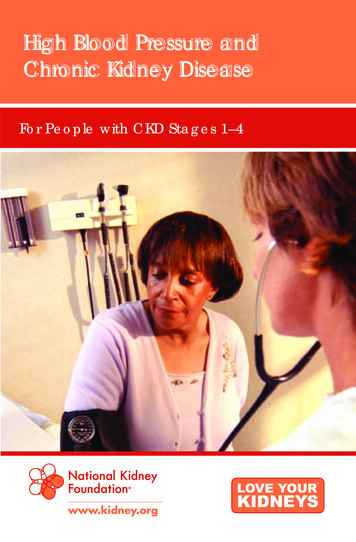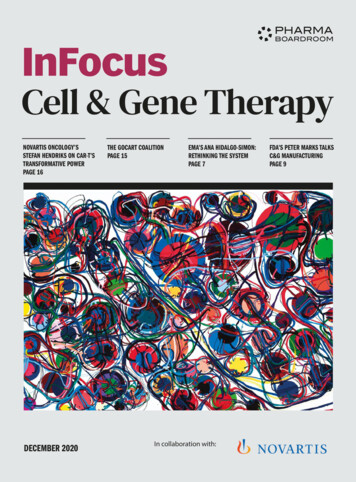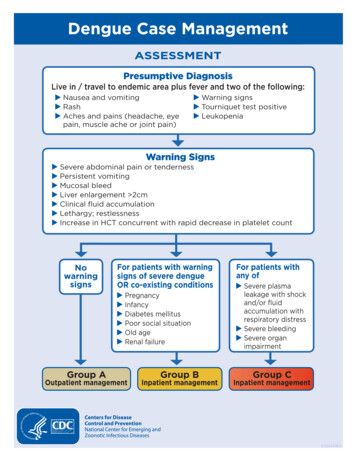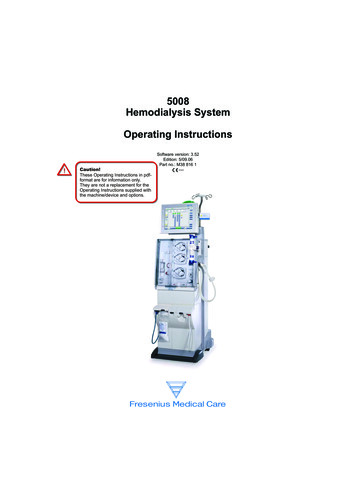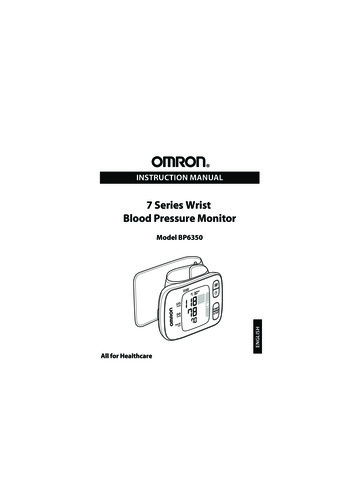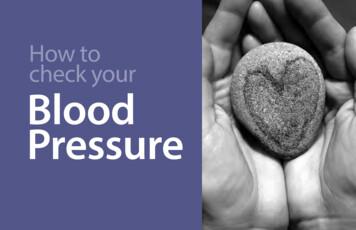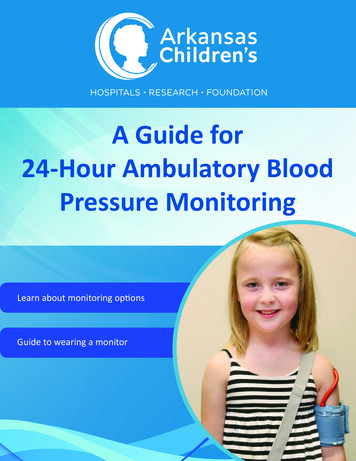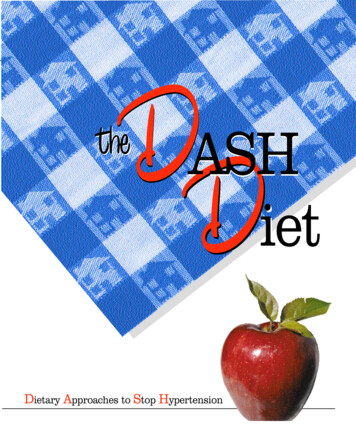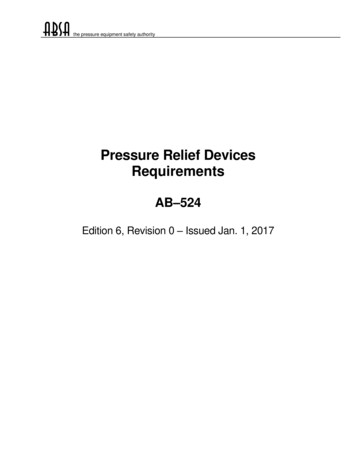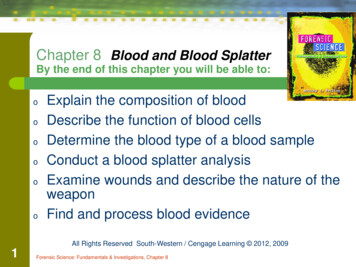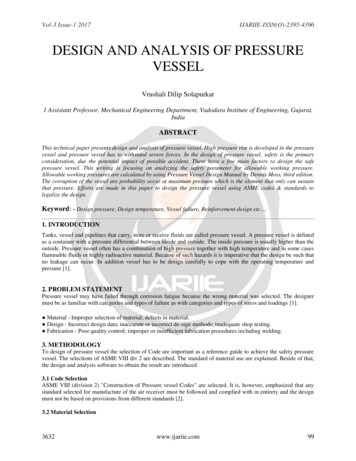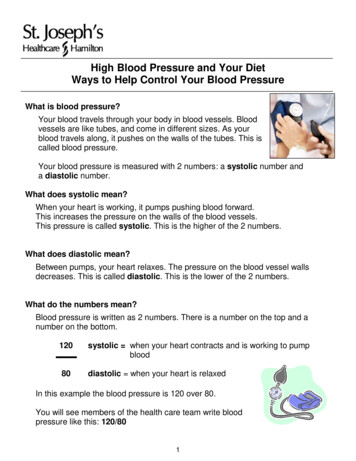
Transcription
High Blood Pressure and Your DietWays to Help Control Your Blood PressureWhat is blood pressure?Your blood travels through your body in blood vessels. Bloodvessels are like tubes, and come in different sizes. As yourblood travels along, it pushes on the walls of the tubes. This iscalled blood pressure.Your blood pressure is measured with 2 numbers: a systolic number anda diastolic number.What does systolic mean?When your heart is working, it pumps pushing blood forward.This increases the pressure on the walls of the blood vessels.This pressure is called systolic. This is the higher of the 2 numbers.What does diastolic mean?Between pumps, your heart relaxes. The pressure on the blood vessel wallsdecreases. This is called diastolic. This is the lower of the 2 numbers.What do the numbers mean?Blood pressure is written as 2 numbers. There is a number on the top and anumber on the bottom.120systolic when your heart contracts and is working to pumpblood80diastolic when your heart is relaxedIn this example the blood pressure is 120 over 80.You will see members of the health care team write bloodpressure like this: 120/801
What is normal blood pressure?Below are general guidelines. Talk to your health care provider about what yourblood pressure should be.Most adultsincluding adults withkidney diseaseLess than 140Adults with diabetesLess than 1309080References: 2014 Canadian Hypertension Education Program Recommendations;2010 National Kidney FoundationWhat does high blood pressure feel like?Most people do not feel high blood pressure. This is why it is important to controlit. High blood pressure that is not well controlled can lead to problems such askidney disease, heart disease and stroke.High blood pressure over a long time causes blood vessels in the body to getthick, narrow and hard. The blood vessels in the heart, brain, and kidneys alsoget narrow and hard. This makes the heart beat faster and pump harder.This can cause a heart attack, stroke or kidney failure.Many things can affect your blood pressure such as the food you eat, theamount of salt or sodium you consume, your weight, your level of physicalactivity, the amount of alcohol you drink, whether or not you smoke and how youmanage stress.The information in this handout shows you how to make changes in your diet tohelp control your blood pressure2
How can I lower my blood pressure?You can lower your blood pressure by making 2 important changes in your diet:1. Eating less salt or sodium2. Following the DASH diet. DASH stands for Dietary Approaches to StopHypertension. There is more about the DASH diet later in this handout.1. Eating Less Salt or SodiumThere are 3 sources of salt or sodium in our diet: added during processing - 77% added at table or in cooking - 11% naturally in foods - 12%Sources of Salt or Sodium in Diet90%80%77%70%60%50%40%30%20%11%12%Added at table or during cookingNaturally in food10%0%Added during processingSource: Journal of the American College of Nutrition, 1991 Most of the salt or sodium in our diet comes from processed orconvenience foods. A low salt or low sodium diet is more than just getting rid of the saltshaker, but that is a good place to start.3
How much sodium should I consume each day?The recommended amount of sodium from all foods and drinks is: 1500 mg a day for adults less than 50 years old 1300 mg a day for adults between the ages of 51 and 70 1200 mg a day for adults over 70No matter how old you are, you should consume no more than 2300 mg ofsodium a day.Most Canadians eat more sodium than this in a day.How do I decrease my intake of salt or sodium?There are 2 important ways you can do this: Get rid of the salt shaker Look for hidden salt in food1. Get rid of the salt shaker Do not use salt at the table or in cooking. Do not use seasonings that havesalt in the name such as celery salt, onion salt, garlic salt or sea salt. To add flavour without salt, use herbs and spices. Fresh garlic, onion orother vegetables can also be used. Make home-made foods. To save time, cook in large amounts and putleftovers in the freezer for future meals.There are 2 types of salt alternates you can use: Products made from dried herbs, vegetables and spices such asMrs. Dash . These products are fine to use. Salt substitutes such as NoSalt or Half Salt . Ask your health careprovider or dietitian if you can use a salt substitute because they containpotassium which you may not be able to have.All salt is the same. For example, sea salt, pickling salt, kosher salt,Himalayan pink salt and fleur de sel all have similar amounts of sodium perteaspoon like regular table salt. They all have similar effects on bloodpressure and raise blood pressure to the same degree.4
2. Look for the hidden salt in foodNow it is time to look for the hidden salt or sodium in food products. This sectionshows you how to: read labels to look for salt or sodium in food products limit your intake of foods high in salt or sodiumWhat foods are high in sodium?In general, canned, convenience or pre-packaged foods tend to be highin sodium. This chart shows the more processed a food is, the higher thesodium content.Effect of Food ProcessingFoodServing SizeTomato, fresh, raw1 mediumSodium mg6Tomatoes, canned, whole½ cup (125 ml)162Tomatoes, canned, stewed½ cup (125 ml)298Tomato juice½ cup (125 ml)345Tomato sauce½ cup (125 ml)721You may need to reduce the amount of processed or convenience foods youhave in your diet.Talk to your dietitian or health care providerabout how much sodium to have each day.How do I know how much sodium is in food?Reading labels can help you find out how much sodium is in food.There are 3 places on a label to find information about salt or sodium: Nutrition Facts table Ingredient List Nutrition ClaimAll packaged foods must have an Ingredient List. The Nutrition Facts table is onmost products and a Nutrition Claim may or may not be listed.5
Nutrition Facts TableThe Nutrition Facts table is usually found on the side of a package.This is the best place to see how much sodium is in the food product.Many facts are listed including calories, fat, carbohydrate, protein and sodium.You must look at the serving size. This will tell you how much sodium is in oneserving.Nutrition FactsPer ½ cup (85 g)AmountCalories 60Fat 0 gSaturated 0 g Trans 0 gCholesterol 0 mgSodium 35 mgCarbohydrate 14 gFibre 3 gSugars 0 gProtein 3 gVitamin AVitamin CCalciumIronAmount of food in one serving.The serving size is the amountmost often eaten. This may or maynot be the serving size you wouldhave.% Daily Value0%0%Amount of sodium in 1 serving.1%5%12%% Daily Value for sodium40%6%2%8%What is % Daily Value (DV)?The % Daily Value tells you if there is a little or a lot of a nutrient, such as sodium,in one serving. Daily values are based on the recommended amount of nutrientsyou should get each day.Daily values are listed on the Nutrition Facts table on a scale from 0% to 100%.As a general guideline, a % Daily Value for sodium of 5% or less is a small amount.Choose food with sodium amounts: less than 200 mg in 1 serving or % Daily Value of sodium less than 10%.6
Ingredient ListEvery food product must have an ingredient list. But not all ingredients say whetherthey are high in salt or sodium. Soy sauce is an example of an ingredient high insodium.You cannot tell how much salt or sodium is in a productjust by reading the ingredient list.Talk to your dietitian if you have questions about a product.Watch for these ingredients that are high in sodium: onion salt baking soda garlic salt baking powder celery salt sodium benzoate soy sauce sodium bicarbonate monosodium glutamate (MSG) sodium citrate brine sodium nitrate sodium saccharinTo find out exactly how much sodium there is in a product, check the Nutrition FactsTable on the package.7
Nutrition ClaimA Nutrition Claim is used to highlight a key nutrition feature of a food product.It is often put on the front of a package in big, bold type.Here are some claims that can be made in Canada about salt and sodium.ClaimDefinitionSodium-free/Salt-freeLess than 5 mg sodium for each serving listedon the package.Low-sodiumNot more than 140 mg sodium or less for eachserving listed on the package.Reduced-sodiumAt least 25% less sodium when compared tothe regular product.Unsalted orNo added saltNo salt or sodium is added to the food duringprocessing.LightlyAt least 50% less added sodium whencompared to the regular product.If a product has “sodium or salt-free” or “low-sodium” on the label, it is OK to eatas long as you eat the recommended serving size.Be careful. Products that have “reduced-sodium”,“unsalted” or “no added salt” on the label can still havetoo much sodium. You will still need to read the NutritionFacts table on the label.What about sodium in some medications?Avoid using non-prescription medications that contain sodium such as laxatives,Eno or AlkaSelter .Some herbal and homeopathic products may also contain sodium.If you have questions, ask your doctor, health care provider or pharmacist.8
Some high sodium foods and low sodium alternativesCorned beef (3 oz or 85 g)Roast beef (3 oz or 85 g)995 mg50 mgCottage cheese (1/2 cup or 125 ml)Pressed or dry cottage cheese, no salt added (1/2 cup)485 mg26 mgGarlic salt (1 tsp or 5 ml)Garlic powder (1 tsp or 5 ml)1480 mg1 mgHam (3 oz or 85 g)Roast pork (3 oz or 85 g)950 mg56 mgInstant oatmeal package (1 pouch)Regular cooking oatmeal (1 cup)255 mg2 mgSalted nuts (1 oz or 30 g)Unsalted nuts (1 oz or 30 g)193 mg2 mg9
What should I do when I eat out?When you are on a low-sodium diet, dining out can be achallenge. Choose restaurants that prepare fresh foods.Do not be afraid to ask for your meal to be speciallyprepared.Tips: Order baked, broiled, steamed or poached foods without breading orsauces. Ask that no salt or salty seasonings, like soy sauce, be added. Limit the amount of salad dressing you use. Ask for dressing onthe side.Can I eat at fast food restaurants?Almost all foods served at fast food restaurants are high in sodium. See thechart on the next page for the sodium content of some common fast foods.Ask for the nutritional information at the fast food restaurant before making yourchoice. Some restaurants can limit the amount of salt and high salt seasoningsthey use.Tips: Choose plain hamburgers or grilled chicken sandwiches with lettuce,tomato and onion. Skip the pickles and other high salt condimentssuch as ketchup, barbecue sauce, or hot sauce. Choose pizza with vegetable toppings instead of pepperoni, sausageand ham toppings.10
Sodium content of some fast foodsFoodSodium contentper servingbean burrito1170 mgchicken noodle soup920 mgchicken nuggets or strips700 mggarden side salad with light dressing220 – 260 mggrilled chicken burger786 mglarge cheeseburger1170 mgsmall hamburger584 mgvegetarian burger700 mg – 1365 mg The sodium content may vary at different restaurants. Ask for the nutritional information at each restaurant before makingyour choice.11
What is the DASH eating plan?The DASH eating plan includes fruits and vegetables, lowfat milk products, whole grains, fish, poultry and nuts.The DASH eating plan is: low in total fat, saturated fat and cholesterol low in salt or sodium – DASH eating planprovides less than 2300 mg of sodium a day low in red meat, sweets and sweeteneddrinks high in fibre high in magnesium, potassium and calcium high in vegetable sources of protein such ascooked legumes such as kidney beans,lentils and chick peasTips for getting started on a DASH eating plan:Making changes to what you eat can be a challenge. You may find it helpful tomake 1 or 2 small changes at a time such as: Add an extra vegetable serving to your lunch and dinner Wash and cut up fresh vegetables ahead of timeand keep them in a clear container in the fridge.This saves time when you want to use them.Keep frozen vegetables to add to stir-frys, casseroles, homemadesoups and sauces. Choose whole grain products when you can. These help fill you up and addfibre to your diet (read the box on the next page). Make a point of having low-fat milk with meals. Replace sweetened drinkswith low-fat milk. Add low-fat milk to cooked cereals and homemade soups. Slowly reduce your portion size if you eat larger portions of meat, fish orpoultry. Fill your plate with more vegetables and whole grain productsinstead.12
Try casseroles, pasta and stir-fry dishes. They aregreat ways to use less meat and more legumes,vegetables and grains. Snack on low-fat yogurt or a small piece of low-fatcheese. Eat fresh or dried fruit that need little or nopreparation and make an easy-to-grab snack. Take the salt shaker off the table, do not add saltin cooking and avoid processed foods. Use lemon or lime juice, herbs and spices to add flavour. Eat a small handful of unsalted nuts and/or seeds several times a week. Enjoy meals made with peas, beans, lentils, edamame, chick peas at leastonce a week. Some ideas include low sodium chili, baked beans, hummusand split pea soup etc.Fibre Tip Increase fibre in your diet slowly. If you increase fibre too quickly or withoutdrinking enough liquids you may have moregas, bloating, cramping, diarrhea orconstipation.1. Add fibre-rich foods slowly to your diet.For example, add one new high fibre foodeach day for one week.2. Drink 8 to 10 cups of fluid a day whenincreasing your fibre intake if you can havethis in your diet. People with heart diseaseand kidney disease, for example, may needto limit the amount of fluids they have. Talk toyour health care provider about this.13
Can lifestyle changes help control blood pressure?Here is how making changes in your lifestyle can help lower high bloodpressure.LifestyleChangeTarget*Eat healthyand lower theamount ofsodium youeatFollow the DASH diet limitssodium to 1500 to 2300 mga dayExerciseregularlyInclude 30 to 60 minutes ofheart-beat raising activity, 4 to 7days a weekLose weight ifyou need to.If you areoverweight,losing 5 kg(10 lb) willlower bloodpressure.Limit alcohol(beer, wine,liquor)Drop inSystolicmmHgDrop inDiastolicmmHg168541142For each 1 kg(2.2 lb) of weight lostHave no more than 2 drinks aday: Men should have no morethan 14 drinks a week Women should have no morethan 9 drinks a week*Source: 2014 Canadian Hypertension Education Program Recommendations14
Other ways to lower blood pressureIf you smoke, quitEach cigarette you smoke raises your blood pressure.Talk to your health care provider about programs tohelp you quit smoking.The Smokers’ Helpline is: 1-877-513-5333 or www.smokershelpline.caReduce your stressIf stress is an issue in your life, see a health careprovider about how to manage your stress.Take blood pressure medication the right wayTake any medication your health care providerprescribes to control your blood pressure.Do not stop taking any medication for high bloodpressure unless told to do so by your health careprovider.15
Menu Makeover(How to lower your intake of sodium over a day)BeforeAfter(4000 mg sodium)mgsodiumBreakfast2550130145351Lunch¾ cup oatmeal, quick cooking2 tbsp natural bran1 cup 1 % milk1 slice whole wheat toast1 tsp margarine1 banana20130145351Lunch1 cup Campbells Chicken Noodle soup900tuna salad sandwich on2 slices whole wheat bread,3 oz white tuna with1 tbsp light mayonnaise8 baby carrots½ cup unsweetenedapplesauce695663Supper1 cup Campbells Healthy RequestChicken Noodle souptuna salad sandwich on2 slices whole wheat bread,3 oz white tuna with1 tbsp light mayonnaise8 baby carrots½ cup 3 oz roasted skinless chickenbreast, no added salt½ cup homemade mashedpotatoes with no addedsalt and 3 tbsp milk3 spears broccoli½ cup yellow beans1 slice whole wheat bread1 tsp margarine1 medium pear2961453511301 cup 1 % milk130368Snack½ cup strawberries1 cup yogurtmgsodiumBreakfast1 package instant oatmeal2 tbsp natural bran1 cup 1 % milk1 slice whole wheat toast1 tsp margarine1 banana3 oz frozen breadedchicken breast½ cup mashed potatoesmade from flakes and3 tbsp milk3 spears broccoli½ cup yellow beans1 slice whole wheat bread1 tsp margarine2 oatmeal cookies,store bought1 cup 1 % milk(2100 mg sodium)4656Snack1125½ cup strawberries1 cup yogurt4000 mg11252100 mg16
Guidelines to eat less sodiumFoodSay YesSay NoGrains, Breadsand Cereals whole grain breads and rollsmuffins, homemadecornbread, homemademost dry cereals such asShredded Wheat ,Shreddies , Weetabix , Life ,Fibre 1 cooked cereals withoutadded saltunsalted crackers,breadsticksand rice cakeslow-sodium or homemadebread crumbsrice, barley, quinoa, couscous,bulgur, kasha, milletspaghetti, macaroni andother pastabread stuffing, homemade breads, rolls and crackers withsalted tops muffin and bread mixes,packaged instant hot cereals pancakes (mixes and frozen) waffles (mixes and frozen) bread stuffing, packaged self-rising flour and biscuit mixes bread crumbs or crackercrumbs, packaged rice and pasta mixes, packaged dry cereals with more than200 mg sodium per serving suchas Special K , Rice Krispies ,Corn Bran , Bran Squares ,Vector Vegetables all fresh and frozenvegetables low sodium or no added saltcanned vegetables low sodium or salt freevegetable juice mashed potatoes, homemade pasta sauce, homemade regular, undrained cannedvegetables sauerkraut, pickles, pickledvegetables and others preparedin brine vegetables seasoned with ham,bacon or salt pork regular vegetable or tomato juice pasta sauce, canned or in a jar instant mashed potatoesFruit most fresh, frozen and canned fruits processed with salt orsodium-containing ingredients all fruit juices(for example, some dried fruits) 17
FoodSay YesSay NoMilk andAlternatives milk, includes chocolatemilk and eggnog soy milk light or partly skimmed hardcheese low fat yogurt ricotta cheese buttermilk, malted milk,milk shake regular hard, processed cheese,cheese spreads and saucesMeat andAlternatives fresh or frozen beef, lamb,pork, poultry, fish andmost shellfish canned tuna or salmon,low sodium canned tuna/salmon rinsed eggs and unflavouredegg substitutes peanut butter, unsalted nuts and seeds, unsalted peas, beans and lentils, dried cottage cheese - dry curd,low sodium Smoked, salted, cured andpickled meats such assausages, hot dogs, bacon,ham, pickled herring, luncheonmeats, canned meats frozen breaded meats pickled eggs salted nuts canned baked beans commercial or store boughtpot pies regular cottage cheeseSoups homemade broths and soupswithout added salt and madewith allowed vegetables commercially canned anddehydrated soups, broths andbouillons with less than500 mg sodium per serving regular canned soups, brothsor bouillon regular dry soup mixes, bouilloncubes, powder or concentratedliquidFats regular salad dressings withbacon fat, bacon bits andsalt pork snack dips made with instantsoup mixes or processedcheese commercially prepared sauces,graviesnon-hydrogenated margarinevegetable oils (unsaturated)salad dressings, low-sodiumsour cream, lightcream, lightcream cheese18
FoodSay YesSay NoOther seasonings or herb shakerssuch as McCormicks No SaltAdded or Mrs. Dash use a salt substitute such asNo Salt with health careprovider’s approval pepper herbs, spices vinegar lemon or lime juice fresh ground horseradish unsalted pretzels, popcorn tortilla chips, low sodium carbonated beverages any seasoning made with saltincluding garlic salt, celery salt,onion salt and seasoned saltand lemon pepper sea salt rock salt kosher salt meat tenderizers meat coating mixes monosodium glutamate regular soy sauce teriyaki sauce steak sauce Worcestershire sauce black bean sauce hoisin sauce canned gravy and mixes salted snack foods olives softened water used for drinkingand cooking artificial fruit flavoured crystalswith salt or sodium-containingingredients instant pudding and cake mixesLimit to 1 serving a day: hot pepper sauce (1 tsp) salsa (2 tbsp) soy sauce, reduced-sodium(1/2 tsp) soy sauce, low sodium(1 serving as labelled) barbecue sauce (1 tbsp) relish (1 tbsp) ketchup (1 tbsp) mustard (1 tbsp)Measurements: tbsp tablespoon (1 tablespoon 15 ml) tsp teaspoon (1 teaspoon 5 ml) mg milligram19
We gratefully acknowledge and thank Hamilton Health Sciences forallowing us to use and adapt much of this information for client centredcare.PD 7687 (06-2015) File: peyles20
There is more about the DASH diet later in this handout. 1. Eating Less Salt or Sodium There are 3 sources of salt or sodium in our diet: added during processing - 77% added at table or in cooking - 11% naturally in foods - 12% Source: Journal of the American College of Nutrition, 1991 Most of the salt or sodium in our diet comes from processed or
